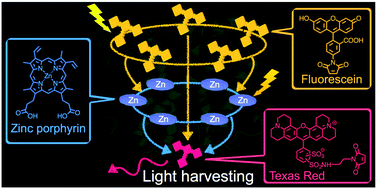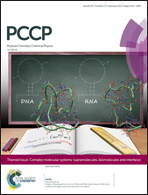Successive energy transfer within multiple photosensitizers assembled in a hexameric hemoprotein scaffold†
Abstract
An assembly of multiple photosensitizers is demonstrated by development of a hexameric hemoprotein (HTHP) scaffold as a light harvesting model to replicate the successive energy transfer occuring within photosensitizer assemblies of natural systems. In our model, six zinc protoporphyrin IX (ZnPP) molecules are arrayed at the heme binding site of HTHP by supramolecular interactions and five fluorescein (Flu) molecules and one Texas Red (Tex) molecule as donor and acceptor photosensitizers, respectively, are attached to the HTHP protein surface with covalent linkages. The flow of excited energy from photoexcited Flu to Tex occurs via two pathways: direct energy transfer from Flu to Tex (path 1) and energy transfer via ZnPP (path 2). Steady state and time-resolved fluorescence measurements reveal that the energy transfer ratio of these pathways (path 1 : path 2) is 39 : 61. These findings indicate that the excited energy originating at five Flu and six ZnPP molecules is collected at one Tex molecule as a funnel-like bottom for light harvesting. The present system using the hexameric hemoprotein scaffold is a promising candidate for construction of an artificial light harvesting system having multiple photosensitizers to promote efficient use of solar energy.

- This article is part of the themed collection: Complex molecular systems: supramolecules, biomolecules and interfaces


 Please wait while we load your content...
Please wait while we load your content...